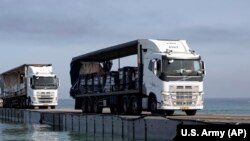More than 1,000 metric tons of humanitarian aid have arrived since Tuesday over the U.S. temporary pier off the coast of Gaza.
However, the aid has not reached any of the Palestinians who need it. Instead, it is sitting on the beach, according to Sabrina Singh, the Pentagon’s deputy press secretary.
The United Nations World Food Program, one of the organizations responsible for distributing the aid, has suspended its deliveries since rocket attacks on its warehouses last week.
It was not immediately clear when the WFP will be able to resume deliveries.
The Pentagon’s Singh said that, for now, the U.S. will focus on getting more aid from Cyprus to the temporary pier and into Gaza so that it is there and ready once the deliveries resume.
The temporary pier, designed as another way to bring aid into Gaza, was just recently reconnected to the Gaza beach after breaking apart in a storm in May.
A large section of the causeway was broken by heavy winds and rough seas. Four U.S. military vessels helping with the mission went aground, injuring three service members. Large sections of the pier were disconnected and moved to an Israeli port for repairs.
The United Nations oversees receiving shipments and coordinating distribution on the ground. The arrangement is part of an effort to boost what humanitarian organizations say is a vastly insufficient amount of aid for Palestinian civilians.
Aid has been slow to get into Gaza due to long backups of vehicles at Israeli inspection points and ongoing Israeli military operations against Hamas. The United States and other nations have air dropped food into Gaza dozens of times in recent months, but air drops are much less efficient and provide vastly smaller quantities of aid than distribution via sea or land.
VOA National Security correspondent Jeff Seldin and VOA’s Pentagon correspondent Carla Babb contributed to this report.









